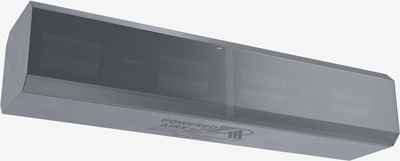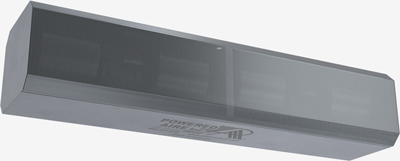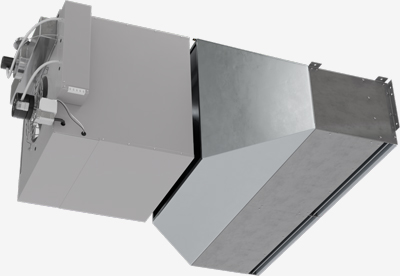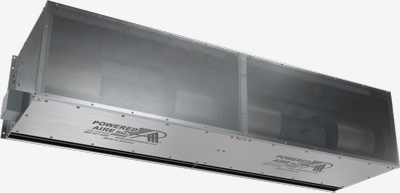Air Curtain Basics: What Is An Air Curtain?
An air curtain is a device that creates a barrier of air across the entire opening of a door that separates two environments.
Most commonly, the air curtain separates conditioned inside air from outside air, preventing the infiltration of cold or hot air, bugs, fumes, humidity, dust and debris. Depending on the industry or even the geographic region, air curtains can be called Fly Fans, Air Barriers, Air Doors or Air Shields.
How Does an Air Curtain Work?
Typically, the air curtain is mounted over a doorway on the inside and the air is pulled into the intake of the unit. There it takes form to match the conditioned environment.
This air is accelerated and forced through a narrow discharge along the length of the air curtain creating a laminar airflow. The discharge angle can be adjusted using the provided turning vanes to achieve optimum performance.
As the discharge angle increases, the air has to travel further until it hits the floor.
Since the velocity of the air decreases as it gets further away from the air curtain, if the discharge angle is too large the air curtain won't be able to stop much wind from entering near the floor. If the discharge angle is too small, the air leaving the unit will not have enough horizontal force to stop a significant gust of wind from entering.
Ideal Velocity
Ideal velocity at the proper mounting height prevents infiltration of outside elements while preventing conditioned inside air from escaping, which boosts energy savings.

Insufficient Velocity
Underpowered air curtain with too little velocity to reach the floor allowing outside air to enter near the bottom of the opening.

Overpowered / Too Much Velocity
Overpowered air curtain with too much velocity causing excessive turbulence at the floor and causing inside air to be blown outside.

Usually the ideal discharge angle for maximum wind-stopping capability is around fifteen degrees. When the discharged air reaches the floor it splits, forcing some air outward and some inward. Therefore, when a unit is used for climate control, it should be placed on the opposite side of the doorway from that of the air that is to be kept out.
For example, if it is winter and you are trying to keep cold outside air from entering a building, the air curtain would be placed on the inside so that it is blowing warm air. When the warm air hits the floor, some is leaked to the outside and some is blown back inside.
If the unit is on the other side of the opening, some of the cold air that needs to be kept out would be blown inside, defeating the purpose. If the unit is to be used for insect control, the air curtain can be mounted on the outside of the doorway as long as the discharge is adjusted so the air is blowing back toward the outside.
In this situation, it doesn't matter if some of the outside air is blown inside after it splits at the floor. This air should already be free of insects because they will not fit through the intake screen.
The Physics Behind Air Curtains Effectiveness
Computational Fluid Dynamics (CFD) is one of the branches of fluid mechanics that uses numerical methods and algorithms, rather than model experiments, to solve and analyze problems that involve fluid flows. Computers are used to perform the millions of calculations required to simulate the interaction of liquids and gases with surfaces defined by boundary conditions.
These CFD images illustrate how air at different temperatures mixes when a door is open.


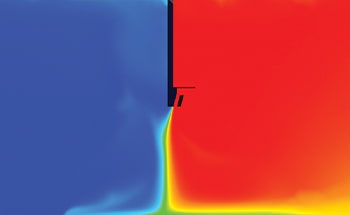

The Technology Inside an Air Curtain
Why Use an Air Curtain?
Temperature + Environmental Separation
A core function of an air curtain is its ability to separate temperatures/separate environments. Whether you're blocking frigid winter winds from entering through a customer entrance door or separating two interior rooms, air curtains create an invisible barrier to prevent the mixing of one environment with another. In Cold Storage applications, the mixing of refrigerated air with ambient air can create safety hazards such as ice, fog and moisture buildup. Air curtains help prevent this while lessening the strain on the unit's cooling refrigeration.
View Case Study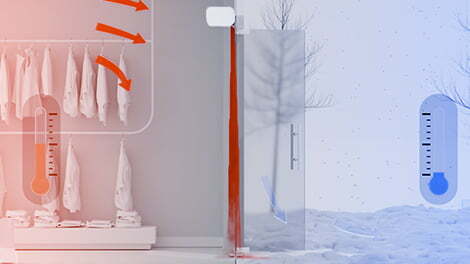
Energy Savings
From Alaska to Florida, air curtains effectively separate environments and complement your building's primary HVAC system, helping drive down costs by lessening the need for the system to constantly be running. While an open door may signal a booming business, it also lets the inside/conditioned air leak out and the outside air seep in. Air curtains prevent the inside air from escaping and the outside air from entering. In turn, the HVAC system will not have to work as hard. Ultimately, this can lead to considerable cost savings.
Try our Cost Savings Calculator to see how much you could save
Increased Comfort for Customers and Employees
Whether a large dock door or a customer front door, the infiltration of unconditioned outside air can make life miserable for those close to the door. That can easily and negatively affect productivity, well-being, performance and sales.
Safety
Perhaps one of the most important and overlooked benefits of an air curtain is its ability to improve the level of safety on doors where it operates. The downward stream of air helps keep the floor free of slipping hazards like water and ice buildup. In busy warehouses, air curtains are an ideal replacement for grimy, dirty strip curtains that impair visibility, which can be particularly dangerous in forklift zones. UVC-based air curtains use UVC light to kill airborne viruses before recirculating clean air back into an area.
Bug Out
Air curtains deter flying pests from entering workplaces. For restaurants and food service industries, this is imperative as insect problems can impact the bottom line. Air curtains create a barrier that significantly reduces flying insects from entering without impacting workflow. As curbside and touchless delivery grows in popularity, air curtains complement these doors by creating a barrier that keeps bugs out but allows for unfettered ingress and egress.
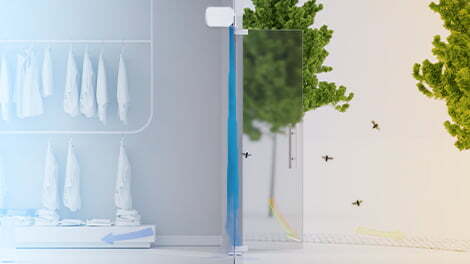
Vestibule Exception
As construction ramps up in the post-pandemic boom, project managers are looking for ways to save time, money and resources. Per the ANSI/AMCA 220 standard, air curtains are now permitted to be used as an alternative to vestibules in select climate zones. Along with the standard, Vestibule Exception air curtains offer considerable cost savings, including less resources since there is no need to build the vestibule (less wood, steel, glass, etc.). This also saves time, money and manpower. In many applications, vestibules are not properly installed, which negates their intended purpose. Along with being more economical, vestibule exception air curtains can also be more effective.
Germ Control
The coronavirus pandemic highlighted the dangers of airborne germ contamination. Extraordinary measures were taken to reduce the transmission of airborne pathogens and Powered Aire's air purifying air curtains are excellent tools to enhance these measures.
Powered Aire's UVC-Aire air curtains incorporate UVC light into an air curtain to create a machine that actively kills airborne viruses before recirculating clean, sanitized air back into an environment. As the germs are pulled into the air curtain, they are exposed to the UVC light, rendering them inactive. The air curtain then expels a barrier of sanitized air. The continual recirculation of air is able to eliminate 99% of airborne viruses without the need to recirculate the air.
UVC-based air curtains can be used above a door for germ control and environmental separation or mounted in common areas such as conference rooms, gyms, lobbies, classrooms or other areas with an influx of people. In these rooms, air purification/germ control is the main function.
Fumes, Dust, Exhaust + Debris Control
In areas with heavy amounts of dust, fumes and debris, air curtains are able to create a barrier that prevents the infiltration of these unwanted byproducts. Of specific benefit, these elements are prevented from entering areas where people work/congregate, which increases overall safety. From drive-thru windows to busy warehouses, being able to block these harmful elements is critical.
What Types of Air Curtains Are Available?
Commercial
Industrial
Specialty

Some of the Best Applications for Air Curtains
Retail
Perhaps the most common application for an air curtain is in a retail setting where an air curtain is placed above a commercial front door, such as a store entrance. During peak hours, these retailers have consistent pedestrian traffic. While the consistent business is great, the constant opening and closing of a door can overwhelm the building's HVAC system, while also letting in bugs, debris, fumes, humidity and excessive heat/cold.
Air Curtains for Retail Applications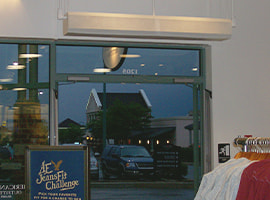
Strip Door Replacement
Strip doors can serve as a cheap method to separate environments. Right up until the time when they are not. Passing through PVC strips can be a dirty, unpleasant experience. As the PVC strips are prone to discoloration and tearing, they require frequent replacement. Furthermore, the dirtier they get, the less safe they become as you cannot see oncoming traffic. It's not uncommon for workers to tie off, cut or push the strips to the side to make their work easier. This negates the strips environmental separation when they are tied off, cut, or pushed to the side, negating their ability to separate environments.
Air Curtains for industrial Use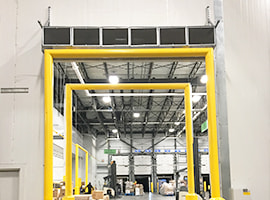
Curbside Delivery
The emergence of curbside, touchless and contactless delivery during the Coronavirus Pandemic created a surge in the popularity of curbside delivery. From restaurants to grocery stores to retail stores, many now offer delivery right to your car, free of contact and extremely efficient. Air curtains can be used on the delivery doors to enable unobstructed access to customers while preventing outside air, insects and car exhaust from entering.
Air Curtains for Curbside Delivery
Food Service
Food service and production facilities are highly regulated and operate under the highest levels of sanitation. With massive prep areas and large delivery doors, they are also quite enticing to insects. As insects and high sanitation standards don't go well together, air curtains are ideal solutions to help prevent the infiltration of flying pests into food service facilities. Along with insect prevention, air curtains can be used to keep hot, humid air from entering.
Food Service Air Curtains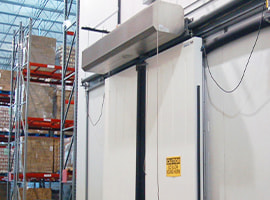
Agriculture / Grow Houses
The continued legalization of cannabis/marijuana for recreational use, as well as increased usage in medical applications, has created a huge demand for the product. Grow houses and greenhouses are being constructed in large numbers and the science, and regulation, behind these businesses require strict control of temperatures and environments. Air curtains help maintain temperatures and prevent the infiltration of insects and unwanted outdoor elements.
Grow House Air Curtains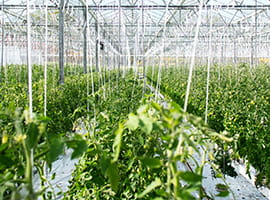
Hospitals, Offices + Schools
While these three places are uniquely different, they all experience consistent traffic coming in and out, and through many different doors. What they have in common is that when their doors are open, it's an invitation for outside air, insects and fumes to enter. Air curtains can be used on front doors, delivery doors, loading docs and other doors to block outside elements, save on energy costs and streamline workflow.
Healthcare Air Curtains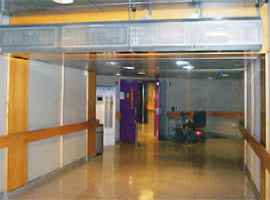
Warehouse
Warehouses are like the industrial equivalent of retail whereas a busy warehouse signals consistent business. A busy warehouse can also mean the constant moving of goods, in and out. When open for even a short period of time, the large dock doors can let in an assortment of unwanted elements, including extreme temperatures, humidity, insects, dust, fumes, and debris. It can also be torture for those working near the doors, who will freeze in the winter months and sweat in the summer. Air curtains for industrial applications and dock doors help create a more comfortable interior by blocking the aforementioned elements. They can also help keep workers more comfortable, productive and safe. In busy warehouses with heavy forklift traffic, visibility is paramount.
Air Curtains for Manufacturing
Restaurant
Few applications are better suited and can benefit more from air curtain usage. From front doors to kitchen delivery doors to curbside pick-up to outdoor dining—there's an air curtain for that. A growing trend in restaurants is to offer garage door or roll-up door access to expanded outdoor seating. Adding air curtains to these doors enables them to remain open during working hours while preventing the infiltration of unwanted outdoor elements such as dust, debris, humidity, fumes and insects. Restaurant back doors are commonly used for deliveries that come in and trash that comes out. The exhaust fans are also located near these doors which creates ideal situations for insects. A strategically placed air curtain on a restaurant back door helps prevent insects and fumes from entering. Lastly, air curtains can be used on delivery, curbside pick-up and other touchless food service delivery options that are becoming more prevalent in the Covid-19 era. As food is delivered to customers waiting outside in their cars, the doors are constantly opened and closed. With an air curtain, a barrier is created to prevent the infiltration of outside air and nuisances. Drive-thru ordering has also skyrocketed during the Coronavirus pandemic. Pass-thru air curtains help protect these small openings, blocking outside air and car exhaust from entering.
Restaurant Air Curtains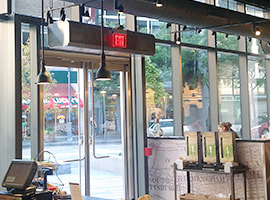
Cold Storage
If you're familiar with cold storage applications (freezers and coolers), you're also familiar with the hazards that can be present around these doors. In cold storage, where forklifts are continually moving between sub-zero freezers to coolers and rooms at ambient temperatures, there is the potential for ice, fog and moisture to accumulate. As the ice gets thicker, so will the fog and moisture, which can compromise worker safety and door performance. Air curtains placed above these doors are ideal. They prevent the conditioned freezer air from escaping while blocking the outside air from entering. Reduced ice, fog and moisture means increased visibility, better performance and improved overall safety.
Learn more about Cold Storage applications here.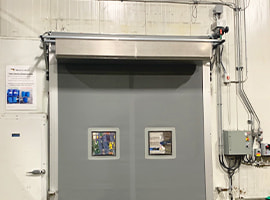
Grocery Stores
Few buildings benefit more from air curtains than grocery stores. From customer entrance doors to curbside pickup to delivery doors, air curtains can be used to protect all sides of a grocery store. There can be a nearly constant flow of people entering and exiting grocery stores, meaning that the doors rarely stay closed for long. As the people enter, so can insects, fumes, dust, debris and unconditioned outside air. Air curtains allow the customers to enter freely while preventing unwanted elements from doing so. With curbside pickup growing in popularity, side doors are being repurposed to make the deliveries as easy as possible. Air curtains can be used on these doors to make delivering the groceries more efficient without sacrificing energy costs or enabling the infiltration of outside air, insects, and car fumes. On the receiving doors, air curtains can also be used to separate environments during deliveries.
Air Curtains for Grocery Stores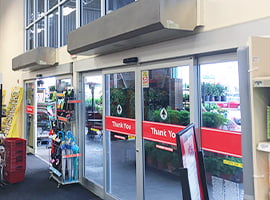
Buying an Air Door? Here's What to Look For.
Not all air curtains are created equal, from design to price to performance, it's critical that the air curtain meets the needs of your application while also being able to withstand the rigors of daily use. And while a “cheaper” unit may save money upfront, it may also end up costing more in terms of a longer installation or poorer performance. Stainless steel air curtains provide an aesthetic boost but will also last considerably longer in regions prone to rust and humidity, such as coastal areas.
Uniformity Is Also Key

A discharge plenum collects the discharged air and creates a uniform flow that covers a larger portion of the door.

Most air curtains aim their blowers directly down from the air curtain. This creates gaps between the blowers through which outside air and insects can pass.
Versatility
As not all air curtains are created equal, neither are the applications where they'll operate. Often, overhead space is limited or the building requires an in-ceiling or low-profile unit to boost aesthetics. Powered Aire's complete line of air curtains ensures the proper fit and usage for the application. More so, it's backed by first-class customer service and support.
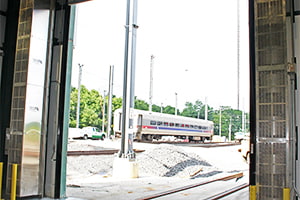
Vertical mount
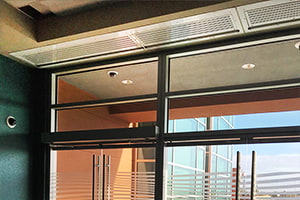
In-ceiling recessed mount
Not sure where to start? Try our Air Curtain Selector tool.
Answer some simple questions and we'll guide you to the units that may be the best fit for your situation.
Air Curtain SelectorAir Curtain Selection & Placement
What to consider when picking and placing an air curtain.
- Air curtain selection is dependent on the width and height of the opening.
- For climate control we recommend that the air curtain be mounted on the inside of the opening. This way the unit is taking in and discharging inside air, which circulates back inside the building. The air curtain will also work for insect control when installed on the inside.
- Putting an air curtain on the outside is primarily for insect control, not climate control. The air curtain takes in outside air and discharges it. When the air hits the ground it splits, with some going out but also some going inside, which defeats the purpose of climate control.
- Typically, the air curtain is mounted above the opening.
- In order to maximize efficiency, the air curtain must cover the entire true opening.
- The air curtain discharge must have a free and clear path over the entire opening for optimum performance.
Other Air Curtain Considerations
Negative Air Pressure
If a building has a negative air pressure due to mechanical exhaust, stack pressure, etc., the air curtain will not be as effective.
Installation Issues
Take note of any obstacles above the opening, and how much room there is to the ceiling on the side of the opening where the air curtain will be mounted.
Vertical Installation
Mounting an air curtain vertically brings the operational noise of the unit to ground level. It is recommended that there be a barrier, or bollards, to protect the air curtain against damage and for employee safety purposes. It is also recommended that a barrier be placed on the opposite side of the opening to stop the air.


